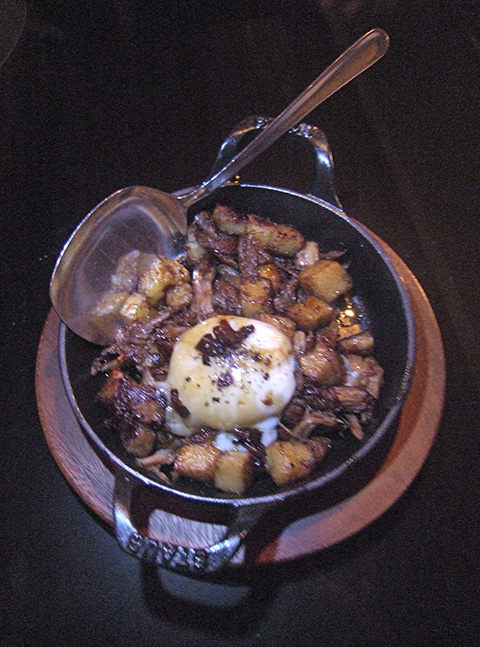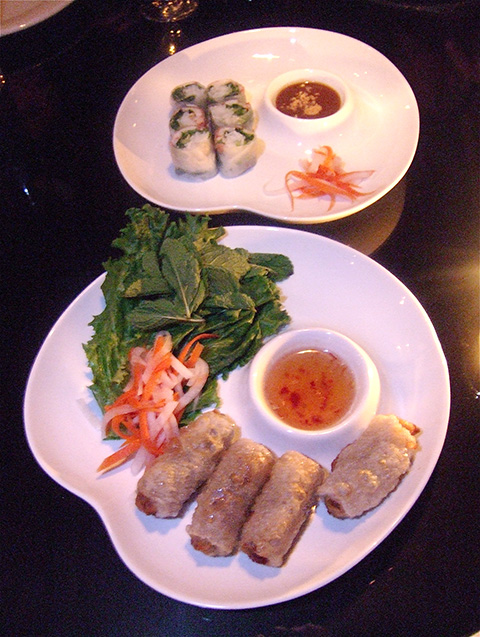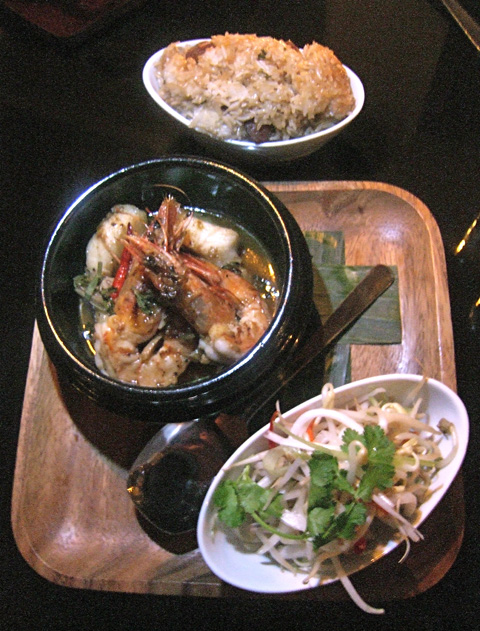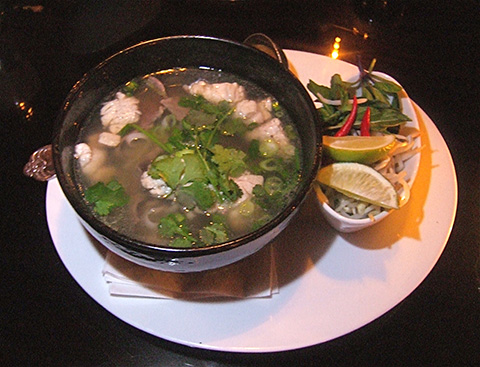October 27, 2008 |
BITE: My Journal
The Bad Boy of Bun Does Good – So Far – at BarBao
 |
| Michael Huynh, the wandering chef, has settled at BarBao for now. Photo: Steven Richter |
The Vietnamese Don Juan of bun and pho Chef Michael Huynh, had the grace to look a little discombobulated at BarBao, his new perch on the Upper West Side where Rain reigned for 13 years, or so it seemed to me. Perhaps I just imagine he feels the weight of his legend as a serial rover and of the numbed partners he has left behind since we discovered him at Bao 111 in 2002 and sent savvy uptowners to brave this new stirring on Avenue C. But maybe it’s not guilt at all, or even embarrassment. Perhaps it’s just jet-lag from the summer in Vietnam. Or the push to master a new kitchen. Michael is here. His food is already very good, even wonderful, exciting enough to bring us back two nights in a row, eager to taste more.
 |
| A tremulous poached egg rides atop the marvelous daikon-bacon hash. Photo: Steven Richter |
Both nights I focus on the roster of small plates and noodles, not just because they’re cheaper – $8 to $14 (for baby lamb lollipops – small chops, sublimely caramelized, lying on a little jalapeňo pesto), but because they sound more Vietnamese. Big plates ($16 to $27) of Berkshire pork belly with braised red cabbage, roasted guinea hen with corn, and crispy red snapper with plum tomatoes and pineapple in a sweet-and-sour sauce strike me as a bow to the timid. Playing it safe on the Upper West Side. Not what diehard Huynh food fans seek.
 |
| Crab spring rolls and summer rolls cut Japanese style. Photo: Steven Richter |
Tight little summer rolls, plump with vegetable, shrimp, duck confit, Berkshire pork or short rib, are delicious and elegant, cut in six pieces, as you would a sushi roll, the better to share. I marvel at the mystery of how pickled white peach chunks came to keep company with marvelous salt and pepper crispy sweetbreads and braised bitter melon in a Chinese sausage vinaigrette. A tremulous slow cooked egg nested on daikon duck hash with duck bacon brings back memories of a favorite from Huynh’s stormy in-and-out days at Bun/Soho. There his menu seemed to be most his own after he had adandoned Mai Place where Drew Nieporent had guided him to a new level of brilliance.
 |
| Giant prawns ride atop the delicious Mekong market clay pot. Photo: Steven Richter |
It’s early. Second night, we’re told. During the day designers Jason Volenec and Silvia Zofio of RKIT are personally pasting collages on the ceiling - like those between wooden panels in the entrance that has the look of a shabby hotel left from Hanoi’s colonial days. The bar top has yet to arrive. There’s a handsome back room bar for snacks. Shredded propaganda posters on one wall in the dining room are meant to look like a bar code. You might not get it, nor recognize cedar grape-stakes that form a ceiling, if you haven’t read the press release. At some point, a bit more color may add a little cheer to the faded antique violet and rose velvet. But there’s a light above every table and even we can read the menu without a flashlight. Big black capital letters suggests boomers and their elders are welcome.
A rotation of eager
 |
| Beef pho with sweetbreads. Photo: Steven Richter |
waiters tries not to seem disorganized. “We serve everything for the table to share and dishes will arrive at random,” they announce with authority, guiding me to the tartest of their $10-$12 cocktails, the “Jane Fonda,” a mix of rum, ginger liqueur and lime. The “peel and eat” chili garlic tiger shrimp are so crisp and fragrant, no one’s peeling. We’re just eating.
We ask to have the yame soup in four bowls – its garlicky broth is lush with rock shrimp, crispy leeks and chunks of Vietnamese potato. The intense broth of the pho noodles gets spooned out at the table, with swirls of rare beef and chunks of voluptuous sweetbread. Mekong Market Clay Pot, with giant prawns, fish and pickled chive is lively and delicious, unlike the rather boring too cooked Iron Pot Chicken. And grilled American Wagyu hanger steak on Asian eggplant is even better the second night – rarer, juicier, wonderfully caramelized. We are instructed to dip each slice in the spicy ginger sauce, drag it through crispy rice bits and pop on a leaf of Thai basil.
Alas, those three baby lamb lollipops are definitely not designed for the four of us to share. We offer to pay for a fourth little chop. “Of course,” says the waiter, returning several minutes later with another order of three chops.
“That’s what the chef wanted to do,” he offers. Not a solution in my book. We also have to ask for lettuce and herbs to wrap the crab spring rolls to dip in its nuoc cham sauce as we would in Vietnam. Opening week jitters, I’m later told. That’s why there’s a 20 per cent discount all week. And supposedly you’ll be able to specify how many lamb pops you want and be charged accordingly from now on.
 |
| American Waygu hanger steak on eggplant with ginger sauce and rice crisps. Photo: Steven Richter |
As often happens when I’m eating Huynh’s food, we’ve over-ordered and no one wants dessert, but out of the kitchen come a squash flan with ginko nuts in red wine puree and an order of Vietnamese beignets – sprinkled with black and white sesame seeds – to dip in Vietnamese coffee-caramel sauce. True to our gourmandlich heritage, we manage to taste.
With food this good and Michael Huynh’s charisma (bad boy or not)…with the stage set-like bar lounge already looking sexy in a neighborhood that needs a sexy bar lounge, I can imagine this place heating up again – as in the early days of Rain. It’s priced to ride out the economic storm. And Main Street partners, Steven Scher, Paul Zweben and Jeff Kadish feel Huynh wants to be in one place and succeed and build on it. “We have committed to each other that this is our focus,” as Sher puts it carefully. “We’ve had success before…with a bad boy. Alex Garcia has a checkered past, but he keeps coming back to Calle Ocho and it’s busier than ever. I am not going to stop him from pursuing other ventures if I’m not willing to do them. We even had a good run with Rocco at Union Pacific,” says Sher.
“Michael is a real talent and he feels things have not gone well because he’s never had the right partner,” Sher goes on. “I looked him in the eye and I saw this talent and I thought it was a good risk for us. We are the right partners for Michael.” And just in case you’re skeptical, sous chef Andrew Chang already has billing on the menu.
100 West 82nd Street near Columbus Avenue. 212 501 0776.
***
Chocolate Heaven, Chocolate Fog
 |
| Temptation from Amadei of Tuscany and the Annual Chocolate Show. Photo: Steven Richter. |
The people who sell chocolate are not merely happy - I think of Jacques Torres, always smiling – they also seem wildly passionate and can be deeply poetic, if not mystical. Chana Krausz-Papp, who left selling wine to become the U.S. rep for Amadei chocolates, is no exception. Amadei is Tuscan chocolate, the most expensive chocolate in the world, she claims. It’s made in an area of Tuscany known as Chocolate Valley, near Pontedera. How often have I been to Tuscany? How many summers have we spent in Pietrasanta on the Tuscan seashore? No one ever mentioned Pontedera. No one ever spoke of Amadei.
Now I learn it is favored by the fussy patissier Pierre Hermé (over the snootiest French chocolate), the visionary Ferran Adria (surely there must be Spanish chocolate), Heston Blumenthal at Fat Duck (the English are notoriously chauvinistic about their chocolate too), and President Sarkozy, who mentioned it among his favorite Italian products. Closer to home, Per Se, Nobu, Fiamma, Daniel and Lever House are fans. Le Bernardin patissier Michael Liaskonis writes about it on his blog. And at Del Posto, they serve the chocolate in bar form, paring it with aged rums.
The Amadei story is romantic and dramatic. Brother and sister Cecilia and Alessio Tessieri, born into a family confectionary business, teethed on making pralines (what I call bon bons, or filled chocolates) and ultimately began producing their own chocolates from the bean itself. She trained to become one of the few women maitre chocolatiers in the world. He scours the globe in search of the best cacao beans, the best plantations in Central and South America and Madagascar, tying up an exclusive for Chuao cocoa from Venezuela.
In her enormous tote, Chana always has a stash of Amadei’s small 5 gram squares in assorted flavors, single origin crus, and of varying cacao pow, that she passes around after dinner. Hmmmm…Venezuela cru hits the spot after too much pizza, I promise you.
She offers to do a tasting for me. After the summer, I say.
As I’ve written, I am not an obsessed chocoholic. I love chocolate. One bite or three seems to me the perfect ending of a meal. But I like Jujee Fruits too, so a serious chocolate purist should probably not trust me. I’m guessing those hopelessly obsessed by chocolate will want to Google Amadei and taste for themselves anyway. It’s sold on-line by the bar and in stunning gift boxes.
Last week Chana came by, low key and soft-spoken, mellifluous - as if her mouth was already full of chocolate. My friend Pamela Morgan of Flavors has been chattering away about Xoçai, a healthy chocolate she is peddling with equal passion, so I invited her to join us. “Xoçai,” says the box, “is rich in unprocessed, non-alkalized, non-fermented cacao powder.” It’s made with “extreme dark” Belgian chocolate, açai and blueberries, with more than half its calories in fat, even saturated fat. Pam is shocked when I point that out. It’s the açai, a powerful anti-oxidant, and the dark, unprocessed chocolate’s total flavonoids that help the body resist damage by free radicals, I’m supposed to be impressed by. An astonishing 1.008 mg. of total flavonoids per 100 calorie serving (3 small squares) and, according to the label, the ORAC value (Oxygen Radical Absorbance Capacity) per serving is 58,700 compared to 2,400 for blueberries. If I need an excuse to have chocolate with my blueberries, this is it.
Chana takes these thrilling health claims quite calmly, noting that Pamela’s chocolate has lecithin as an emulsifier, which Amadei would never, never, ever. “We don’t talk about the health aspect of chocolate,” she says, handing out bits of Amadei --“Let it melt on your tongue,” she begins her spiel.
“We are all about the sensuality of chocolate, the emotion, the pleasure of the senses.”
After the brown (or milk chocolate), the Toscano black 63%, the 70%, the Amadei 9, the grand crus of single variety beans – Grenada, Jamaica, Ecuador, Madagascar, Venezuela, the fabled Chuao - a few interruptions of Xoçai, comes the climactic Toscana red – extra bitter chocolate fondente, 70% cacoa with strawberries, raspberries and cherries. Chana smiles knowingly as she breaks off a chunk for each of us.
Oh dear heaven. I’ve found my chocolate. I cannot go on. Chana wisely folds her tent and her tote.
If you think you know everything there is to know about chocolate, you will surely want to meet Krausz-Papp. She will be telling the Amadei story and passing out samples to melt on your tongue at the 11th annual New York Chocolate Show from November 7-9 on Pier 94 (711 12th Avenue at 55th Street). It launches with a Chocolate Couture Collection – creations from designers working with pastry chefs and chocolatiers. There’s a KidZone and a Blackberry hand massage op. In the overstuffed shopping bag the promoters sent, I found white chocolate pops and cocoa butter skin cream, Berkshire bark and dark chocolate with chipotle, salt and popping candy. I’ve been giving it away as fast as I can.
The truth is, my afternoon with Chana and Pamela ended on a very scary note. Halfway home I disappeared into a fugue state, but kept on walking in my chocolate fog. I didn’t know where I was or where I was going. A sugar fit perhaps. I woke up in my own bed two hours later. I never did figure out what happened.
“I’m so glad you’re up,” the Road Food Warrior greeted me. “I was afraid to wake you, but it’s past time for dinner.” I stood up slowly. My brain was back. My pulse was normal. I felt myself again. We went out to dinner.
Amadei is available in New York at The World of Chocolate, Ideal Cheese, Sant Ambreous (pralines only), and The Chocolate Room (two locations) in Brooklyn.
***